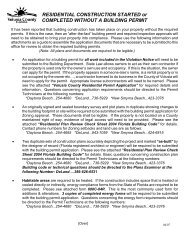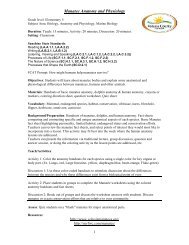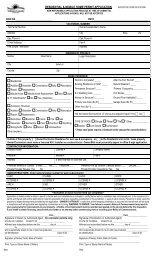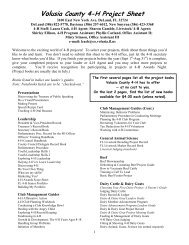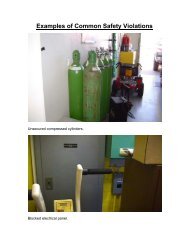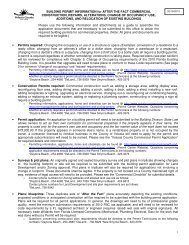Local mitigation strategy (LMS) - Volusia County Government
Local mitigation strategy (LMS) - Volusia County Government
Local mitigation strategy (LMS) - Volusia County Government
You also want an ePaper? Increase the reach of your titles
YUMPU automatically turns print PDFs into web optimized ePapers that Google loves.
SECTION 5: HAZARD PROFILES5.10 FLOOD5.10.1 BackgroundFlooding is the most frequent and costly natural hazard in the United States, a hazard that has causedmore than 10,000 deaths since 1900. Nearly 90 percent of presidential disaster declarations result fromnatural events where flooding was a major component.Floods generally result from excessive precipitation, and can be classified under two categories: generalfloods, precipitation over a given river basin for a long period of time along with storm-induced wave ortidal action; and flash floods, the product of heavy localized precipitation in a short time period over agiven location. The severity of a flooding event is typically determined by a combination of several majorfactors, including: stream and river basin topography and physiography; precipitation and weatherpatterns; recent soil moisture conditions; and the degree of vegetative clearing and impervious surface.A general flood is usually a long-term event that may last for several days. The primary types of generalflooding include riverine, coastal, and urban flooding. Riverine flooding is a function of excessiveprecipitation levels and water runoff volumes within the watershed of a stream or river. Coastal floodingis typically a result of storm surge, wind-driven waves and heavy rainfall produced by hurricanes,tropical storms and other large coastal storms 14 . Urban flooding occurs where manmade developmenthas obstructed the natural flow of water and decreased the ability of natural groundcover to absorb andretain surface water runoff.Most flash flooding is caused by slow-moving thunderstorms in a local area or by heavy rains associatedwith hurricanes and tropical storms. However, flash flooding events may also occur from a dam or leveefailure within minutes or hours of heavy amounts of rainfall, or from a sudden release of water held by aretention basin or other stormwater control facility. Although flash flooding occurs most often alongmountain streams, it is also common in urbanized areas where much of the ground is covered byimpervious surfaces.The periodic flooding of lands adjacent to rivers, streams and shorelines (land known as floodplain) is anatural and inevitable occurrence that can be expected to take place based upon established recurrenceintervals. Floodplains are designated by the frequency of the flood that is large enough to cover them.For example, 100-year floodplain by the 1 percent annual chance flood.The frequency of flood events, such as the 1 percent annual chance flood, is determined by plotting agraph of the size of all known floods for an area and determining how often floods of a particular sizeoccur. Another way of expressing the flood frequency is the chance of occurrence in a given year, whichis the percentage of the probability of flooding each year. For example, the 1 percent annual chanceflood refers to area in the 100-year floodplain and has a 1 percent chance of occurring in any given year.Similarly, the 0.2 percent flood covers the 500-year floodplain and has a 0.2 percent chance of occurringin any given year. The recurrence interval of a flood is defined as the average time interval, in years,14 While briefly mentioned here, coastal flooding is more thoroughly addressed under the “storm surge” hazard.<strong>Volusia</strong> <strong>County</strong> Multi-jurisdictional <strong>Local</strong> Mitigation StrategyFebruary 20105:47




